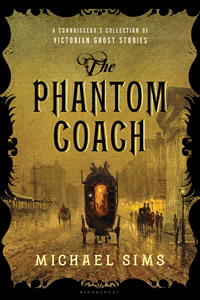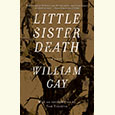Victorian Chills and Thrills
The Phantom Coach by Michael Sims is a supernatural smorgasbord
In The Phantom Coach: A Connoisseur’s Collection of Victorian Ghost Stories, seasoned anthology editor Michael Sims has compiled a book sure to send a shiver down the spine of even the most skeptical reader. Included are all the standard tropes of the genre: haunted houses, the walking dead, cursed objects, and eerie landscapes, as well as the expected Victorian flourishes of fainting females and their brave but clueless male champions. The Victorian era was a golden age for the ghost story: an emphasis on rationalism was slowly being edged out by a growing interest in mysticism. As Sims explains, “skepticism had given way to a new thirst for the eerie and emotionally chaotic.”
 Sims’s eloquent introduction provides the perfect backdrop for the stories that follow, describing the rise of periodical literature, which favored short fiction; its inexpensive means of production and distribution; and the influence of the most famous writer of his day, Charles Dickens, who loved a good ghost story and wrote a number of his own, most famously, “A Christmas Carol.” The familiar tale of Ebenezer Scrooge does not appear in this volume, although Sims includes another of Dickens’s stories, along with selections from other well-known names of the era, including Arthur Conan Doyle, Rudyard Kipling, and Henry James.
Sims’s eloquent introduction provides the perfect backdrop for the stories that follow, describing the rise of periodical literature, which favored short fiction; its inexpensive means of production and distribution; and the influence of the most famous writer of his day, Charles Dickens, who loved a good ghost story and wrote a number of his own, most famously, “A Christmas Carol.” The familiar tale of Ebenezer Scrooge does not appear in this volume, although Sims includes another of Dickens’s stories, along with selections from other well-known names of the era, including Arthur Conan Doyle, Rudyard Kipling, and Henry James.
Other names will be less familiar to casual readers. As in his previous anthologies, Sims takes great care to highlight the contributions of female authors to the genre. “For a quarter century beginning around 1860,” he writes, “most of the stylish and innovative writers of ghost stories were women.” Included in the volume are excellent selections by Amelia B. Edwards and Margaret Oliphant. In all, a third of the stories are by women and represent some of the eeriest and most interesting tales.
Why our fascination with ghost stories? Sims believes it has to do with “the great chilling fact of human life: that it’s brief, linear, and moves toward the grave as swiftly as an arrow. Ghost stories permit us to peek behind the shroud.” Ambrose Bierce’s “The Moonlit Road” provides a perfect example of this point when a spirit, through a medium, gives a poignant account of her painful ghostly existence. “You think that we are of another world,” Bierce writes. “No, we have knowledge of no world but yours, though for us it holds no sunlight, no warmth, no music, no laughter, no song of birds, nor any companionship. O God! What a thing it is to be a ghost, cowering and shivering in an altered world, a prey to apprehension and despair!”
 The longest story in the collection is also one of the most powerful: Margaret Oliphant’s 1896 tale, “The Library Window.” Oliphant tells the story of a young girl captivated by what she sees in the window across the street from her aunt’s home—a window that may or may not actually exist. The beautifully written narrative often focuses on the quality of the summer light, as the girl sits gazing from her window-seat perch. Oliphant writes, “This was the after-light of the wonderful, long, long, summer evening, the light without shadows. It had a spell in it, and sometimes it made me afraid: and all manner of strange thoughts seemed to come in, and I always felt that if only we had a little more vision in our eyes we might see beautiful folk walking about in it, who were not of our world.”
The longest story in the collection is also one of the most powerful: Margaret Oliphant’s 1896 tale, “The Library Window.” Oliphant tells the story of a young girl captivated by what she sees in the window across the street from her aunt’s home—a window that may or may not actually exist. The beautifully written narrative often focuses on the quality of the summer light, as the girl sits gazing from her window-seat perch. Oliphant writes, “This was the after-light of the wonderful, long, long, summer evening, the light without shadows. It had a spell in it, and sometimes it made me afraid: and all manner of strange thoughts seemed to come in, and I always felt that if only we had a little more vision in our eyes we might see beautiful folk walking about in it, who were not of our world.”
Another candidate for most stylish and effective prose is Doyle’s 1883 story, “The Captain of the Pole-Star,” in which Doyle mines his own experience aboard an Arctic whaling vessel as a young man. He was greatly affected by his voyage, once referring to the Arctic as “that mysterious region, which can be the most lovely and the most repellent on earth.” In this tale of a lonely, guilt-stricken ship’s captain creeping ever closer to madness, he builds his portrait one careful step at a time, perfectly capturing the alien desolation of the landscape: “I think I have already mentioned the extraordinary silence which prevails in these frozen seas. In other parts of the world, be they ever so barren, there is some slight vibration of the air—some faint hum, be it from the distant haunts of men, or from the leaves of the trees, or the wings of the birds, or even the faint rustle of the grass that covers the ground. One may not actively perceive the sound, and yet if it were withdrawn it would be missed. It is only here in these Arctic seas that stark, unfathomable stillness obtrudes itself upon you in all its gruesome reality. You find your tympanum straining to catch some little murmur, and dwelling eagerly upon every accidental sound within the vessel.” Of course it’s a set-up; what comes next rightly sets your teeth on edge.
In Amelia B. Edwards’s 1864 story, “The Phantom Coach,” which Sims calls “the quintessential Victorian ghost story,” an unwary hunter who loses his way in a snowstorm at night is startled by the sudden appearance of a sullen servant, who leads him to a foreboding mansion, home to a learned hermit who speaks eloquently on a variety of subjects. Finally their conversation comes round to the matter at hand: “He spoke of the soul and its aspirations; of the spirit and its powers; of second sight; of prophecy; of those phenomena which, under the names of ghosts, spectres, and supernatural appearances, have been denied by the sceptics and attested by the credulous, of all ages.” The traveler, now refreshed by food and rest, is thus primed for supernatural adventure, as he sets out, still under cover of darkness, to hurry home to his worried wife. A little advice: hold on to your seat; phantom coach or not, it’s going to be a bumpy, spine-tingling, thoroughly enjoyable ride.
A graduate of Auburn University, Tina LoTufo has worked as a technical editor at an engineering firm and as an editorial assistant at Peachtree Publishers, where she worked on books by Erskine Caldwell, Will Campbell, and Ferrol Sams, to name a few. She lives in Chattanooga.


